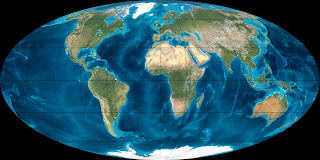
The Earth began to cool down about 4.4 billion years ago. The outer layer hardened and formed the earth’s crust. Continents and seas lie on top of the crust, and we find a layer of liquid rock called the mantle underneath it. The heat from the earth’s core ensures that the mantle is always moving. There are cracks in the crust because of these movements, and for this reason, the Earth is sectioned into different areas that we call tectonic plates. But why does the mantle move when the heat comes from the center of the earth? This activity lets you study this phenomenon with a pot and flatbread.
Equipment
- A pot or a heat-resistant see-through measuring cup
- A stovetop
- 300-500 ml oil
- Food colouring
- Flatbread or another thin and wide cracker
- Parchment paper
- Peanut butter or soft margarine/plant-based butter
Instructions
- Pour oil into the pot so that you get a layer of oil at least 5 cm tall
- Drip a few drops of food colouring. This will help trace the oil’s movements
- Turn on the heat and see what happens. This is your model for the mantle
- To demonstrate what happens when tectonic plates move, use flatbread as tectonic plates and parchment paper with peanut butter or margarine for the mantle. Glide the flatbread on the parchment paper to illustrate movement
- Press two pieces of flatbread against one another and let one glide beneath the other. An enormous pressure hits the lower tectonic plate when this happens. It turns extremely hot and melts. A melted tectonic plate is called magma, and the magma erupts as lava when pressure is applied to it
- Apply water to one end of two flatbreads so that they turn soft, and push towards one another and the soft ends bend upwards. The earth’s mountain ranges formed in a similar way, when two tectonic plates collide
- Place two new flat breads next to one another and rub them together. They pull at each other. Earthquakes happen when this occurs between tectonic plates
What happens?
Oil heated in a pot moves up and down in the same way that the mantle moves up and down. The oil closest to the stovetop expands when it gets hot and rises. It falls back to the bottom as it cools and gets a higher density. We call this “mantle convection.”
The earth’s crust is composed of tectonic plates because of its cracks. These plates have moved away from and crashed with each other many times for billions of years. Today, there are nine large and a host of smaller tectonic plates. They usually only move with a couple of centimeters every year. But it adds up. The changes are quite large and drastic from a time scale of millions of years.
The Earth began to cool down about 4.4 billion years ago. The outer layer hardened and formed the earth’s crust. Continents and seas lie on top of the crust, and we find a layer of liquid rock called the mantle underneath it. The heat from the earth’s core ensures that the mantle is always moving…..Click to read more
